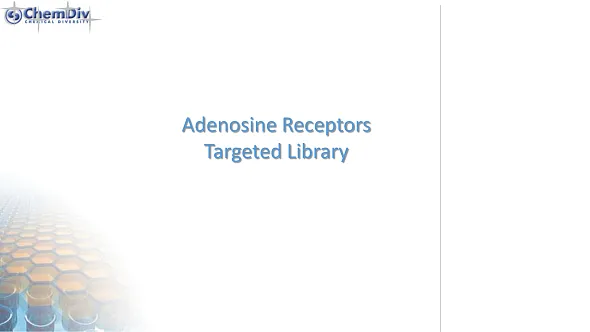Adenosine Receptors Targeted Library
ChemDiv’s library of small molecules targeting adenosine receptors comprises 21,000 compounds.
Adenosine is a well-studied intermediary metabolite, serving as both a building block for nucleic acids and a component of the biological energy unit, ATP. Additionally, adenosine functions as a signaling molecule through the activation of four distinct adenosine receptors, namely, A1, A2A, A2B, and A3. These receptors are widely expressed and play roles in various biological functions, both physiological and pathological. These roles span across cardiac rhythm and circulation, lipolysis, renal blood flow, immune function, sleep regulation, and angiogenesis. They are also implicated in pathological conditions such as inflammatory diseases, ischemic disorders, and neurodegenerative problems.
The therapeutic potential of targeting adenosine receptors has been recognized within recent decades. Selective adenosine agonists and antagonists were discovered and studied, with several clinical trials currently underway. However, the greatest challenge in developing specific adenosine receptor ligands for clinical use is the pervasive nature of adenosine signaling. Adenosine is present throughout the body, and its receptors are extensively distributed, making targeted therapy a complex task [1].
The small molecule library targeting adenosine receptors is a specialized collection intentionally designed for the exploration and development of novel therapeutics in areas with adenosine signaling involved. Our library contains a diverse range of compounds that act as either agonists or antagonists to the four adenosine receptor subtypes (A1, A2A, A2B, and A3), each with unique expression patterns and physiological roles. Given the involvement of these receptors in a multitude of biological processes and diseases, ranging from cardiac function, immune responses, and sleep regulation to inflammatory conditions and neurodegenerative disorders, the library presents a valuable resource for drug discovery. It offers a comprehensive toolkit to investigate the therapeutic potential of modulating adenosine receptors, aiming to address a wide gamut of clinical challenges through targeted pharmacological intervention. The diversity of the library not only aids in identifying potent and selective compounds but also in understanding the complex pharmacology of adenosine receptors, thereby paving an avenue for innovative treatment development.
References
[1] Chen, J.-F., Eltzschig, H. K., & Fredholm, B. B. (2013). Adenosine receptors as drug targets — what are the challenges? Nature Reviews Drug Discovery, 12(4), 265–286. doi:10.1038/nrd3955
